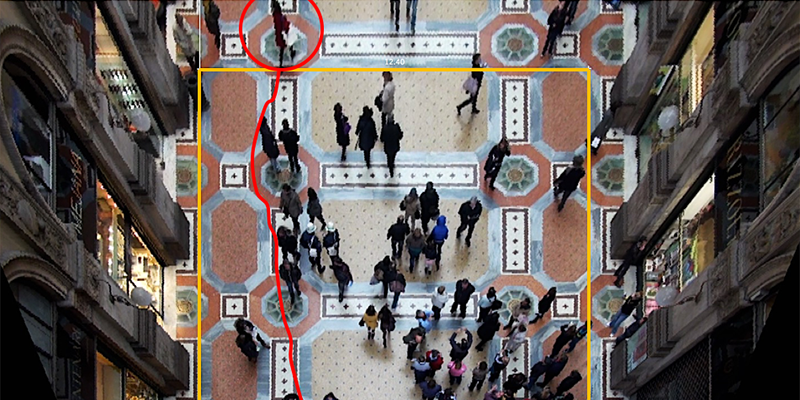Age and Group-driven Pedestrian Behaviour: from Observations to Simulations
DOI:
https://doi.org/10.17815/CD.2016.3Keywords:
pedestrian, observation, simulation, ageing, groups, proxemicsAbstract
The development of pedestrian simulation systems requires the acquisition of empirical evidences about human behaviour for sake of model validation. In this framework, the paper presents the results of an on field observation of pedestrian behaviour in an urban crowded walkway. The research was aimed at testing the potentially combined effect of ageing and grouping on speed and proxemic behaviour. In particular, we focused on dyads, as the most frequent type of groups in the observed scenario. Results showed that in situation of irregular flows elderly pedestrians walked the 40% slower than adults, due to locomotion skill decline. Dyads walked the 30% slower than singles, due to the need to maintain spatial cohesion to communicate (proxemics). Results contributed to refine the parametric validation of the agent-based simulation system ELIAS38.References
Heilig, G.K.: World urbanization prospects: the 2011 revision. United Nations, Department of Economic and Social Affairs (DESA), Population Division, Population Estimates and Projections Section, New York (2012)
Abley, S.: Walkability scoping paper. Charted Traffic and Transportation Engineering 4, 2011 (2005)
Gorrini, A., Bandini, S., Vizzari, G.: Empirical investigation on pedestrian crowd dynamics and grouping. In: Traffic and Granular Flow'13, pp. 83-91. Springer (2015). doi:10.1007/978-3-319-10629-8_10
Vizzari, G., Manenti, L., Crociani, L.: Adaptive pedestrian behaviour for the preservation of group cohesion. Complex Adaptive Systems Modeling 1(1), 1-29 (2013). doi:10.1186/2194-3206-1-7
Bandini, S., Mondini, M., Vizzari, G.: Modelling negative interactions among pedestrians in high density situations. Transportation research part C: emerging technologies 40, 251-270 (2014). doi:10.1016/j.trc.2013.12.007
World Health Organization: Global age-friendly cities: A guide. World Health Organization (2007)
Schaie, K.W., Willis, S.L.: Handbook of the Psychology of Ageing. Academic Press (2010)
Wesley Burgess, J.: The social biology of human populations: Spontaneous group formation conforms to evolutionary predictions of adaptive aggregation patterns. Ethology and Sociobiology 10(5), 343-359 (1989). doi:10.1016/0162-3095(89)90024-1
Webb, J.D., Weber, M.J.: Influence of sensory abilities on the interpersonal distance of the elderly. Environment and behavior 35(5), 695-711 (2003). doi:10.1177/0013916503251473
Winogrond, I.R.: A comparison of interpersonal distancing behavior in young and elderly adults. The International Journal of Aging and Human Development 13(1), 53-60 (1981)
Moussaïd, M., Perozo, N., Garnier, S., Helbing, D., Theraulaz, G.: The walking behaviour of pedestrian social groups and its impact on crowd dynamics. PloS one 5(4), e10047 (2010). doi:10.1371/journal.pone.0010047
Zanlungo, F., Ikeda, T., Kanda, T.: Potential for the dynamics of pedestrians in a socially interacting group. Physical Review E 89(1), 012811 (2014). doi:10.1103/PhysRevE.89.012811
Challenger, W., Clegg, W., Robinson, A.: Understanding crowd behaviours: Guidance and lessons identified. UK Cabinet Office (2009)
Templeton, A., Drury, J., Philippides, A.: From mindless masses to small groups: Conceptualizing collective behavior in crowd modeling. Review of General Psychology 19, 215-229 (2015). doi:10.1037/gpr0000032
Costa, M.: Interpersonal distances in group walking. Journal of Nonverbal Behavior 34(1), 15-26 (2010). doi:10.1007/s10919-009-0077-y
Mawson, A.R.: Mass panic and social attachment: the dynamics of human behavior. Ashgate Publishing Company (2007)
Bandini, S., Gorrini, A., Vizzari, G.: Towards an integrated approach to crowd analysis and crowd synthesis: A case study and first results. Pattern Recogn. Letters 44, 16-29 (2014). doi:10.1016/j.patrec.2013.10.003
Gifford, R.: Research Methods for Environmental Psychology. Wiley Blackwell & Sons, Oxford, UK (2016)
Goodwin, C.J.: Research in psychology: Methods and design. John Wiley & Sons (2009)
World, M.A.G.A.: World medical association declaration of helsinki: ethical principles for medical research involving human subjects. International journal of bioethics 15(1), 124 (2004)
Gilbert, G., Troitzsch, K.: Simulation for the social scientist. Open Univ Press (2005)
Helbing, D.: Traffic and related self-driven many-particle systems. Reviews of modern physics 73(4), 1067-1141 (2001). doi:10.1103/RevModPhys.73.1067
Nishinari, K., Kirchner, A., Namazi, A., Schadschneider, A.: Extended floor field ca model for evacuation dynamics. IEICE Transactions on information and systems 87(3), 726-732 (2004)
Ferber, J.: Multi-agent systems: an introduction to distributed artificial intelligence, vol. 1. Addison-Wesley Reading (1999)
Bandini, S., Crociani, L., Gorrini, A., Vizzari, G.: An agent-based model of pedestrian dynamics considering groups: A real world case study. In: Intelligent Transportation Systems (ITSC), 2014 IEEE 17th International Conference on, pp. 572-577. IEEE (2014). doi:10.1109/ITSC.2014.6957751
Milazzo II, J.S., Rouphail, N.M., Hummer, J.E., Allen, D.P.: Quality of service for interrupted-flow pedestrian facilities in highway capacity manual 2000. Transportation Research Record: Journal of the Transportation Research Board 1678(1), 25-31 (1999). doi:10.3141/1678-04
Fruin, J.J.: Pedestrian planning and design. New York: Metropolitan Association of Urban Designers and Environmental Planners (1971)
Willis, A., Gjersoe, N., Havard, C., Kerridge, J., Kukla, R.: Human movement behaviour in urban spaces: Implications for the design and modelling of effective pedestrian environments. Environment and Planning B Planning and Design 31(6), 805-828 (2004). doi:10.1068/b3060
Schultz, M., Schulz, C., Fricke, H.: Passenger dynamics at airport terminal environment. In: Pedestrian and Evacuation Dynamics 2008, pp. 381-396. Springer (2010). doi:10.1007/978-3-642-04504-2_33
Khan, S.D., Vizzari, G., Bandini, S., Basalamah, S.: Detection of social groups in pedestrian crowds using computer vision. In: Advanced Concepts for Intelligent Vision Systems, pp. 249-260. Springer (2015). doi:10.1007/978-3-319-25903-1_22
Solera, F., Calderara, S., Cucchiara, R.: Socially constrained structural learning for groups detection in crowd. IEEE Transactions on Pattern Analysis and Machine Intelligence 38(5), 995-1008 (2015). doi:10.1109/TPAMI.2015.2470658
Crociani, L., Piazzoni, A., Vizzari, G., Bandini, S.: When reactive agents are not enough: Tactical level decisions in pedestrian simulation. Intelligenza Artificiale 9(2), 163-177 (2015). doi:10.3233/IA-150086

Downloads
Published
How to Cite
Issue
Section
License
Copyright (c) 2016 Andrea Gorrini, Giuseppe Vizzari, Stefania Bandini

This work is licensed under a Creative Commons Attribution 4.0 International License.
Authors contributing to Collective Dynamics agree to publish their articles under the Creative Commons Attribution 4.0 license.
This license allows:
Share — copy and redistribute the material in any medium or format
Adapt — remix, transform, and build upon the material
for any purpose, even commercially.
The licensor cannot revoke these freedoms as long as you follow the license terms.
Authors retain copyright of their work. They are permitted and encouraged to post items submitted to Collective Dynamics on personal or institutional websites and repositories, prior to and after publication (while providing the bibliographic details of that publication).








